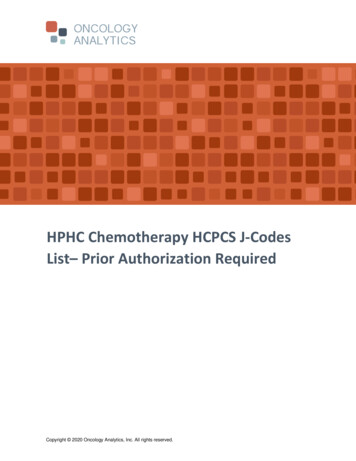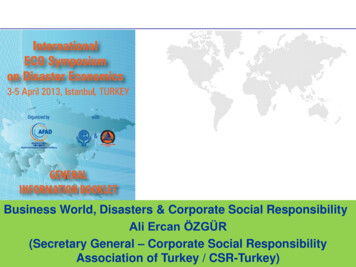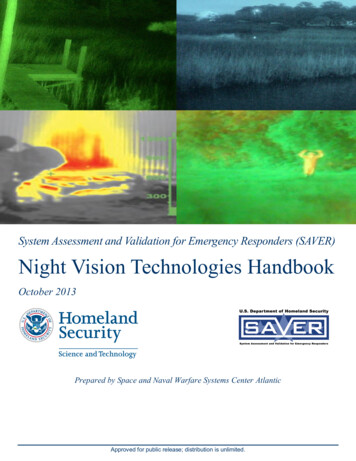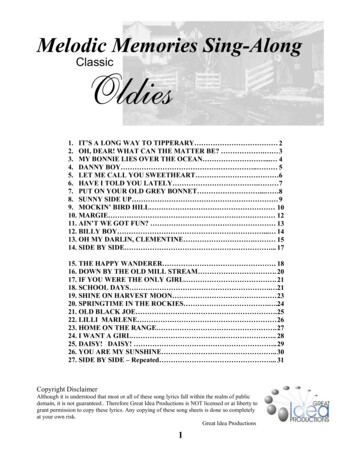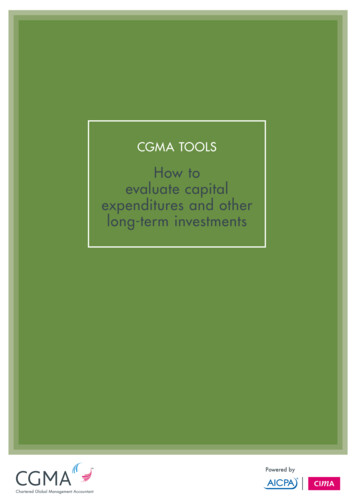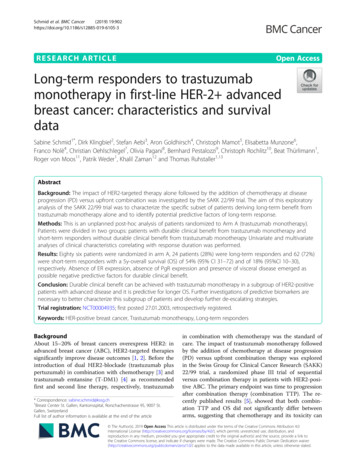
Transcription
Schmid et al. BMC Cancer(2019) EARCH ARTICLEOpen AccessLong-term responders to trastuzumabmonotherapy in first-line HER-2 advancedbreast cancer: characteristics and survivaldataSabine Schmid1*, Dirk Klingbiel2, Stefan Aebi3, Aron Goldhirsch4, Christoph Mamot5, Elisabetta Munzone6,Franco Nolè4, Christian Oehlschlegel7, Olivia Pagani8, Bernhard Pestalozzi9, Christoph Rochlitz10, Beat Thürlimann1,Roger von Moos11, Patrik Weder1, Khalil Zaman12 and Thomas Ruhstaller1,13AbstractBackground: The impact of HER2-targeted therapy alone followed by the addition of chemotherapy at diseaseprogression (PD) versus upfront combination was investigated by the SAKK 22/99 trial. The aim of this exploratoryanalysis of the SAKK 22/99 trial was to characterize the specific subset of patients deriving long-term benefit fromtrastuzumab monotherapy alone and to identify potential predictive factors of long-term response.Methods: This is an unplanned post-hoc analysis of patients randomized to Arm A (trastuzumab monotherapy).Patients were divided in two groups: patients with durable clinical benefit from trastuzumab monotherapy andshort-term responders without durable clinical benefit from trastuzumab monotherapy Univariate and multivariateanalyses of clinical characteristics correlating with response duration was performed.Results: Eighty six patients were randomized in arm A, 24 patients (28%) were long-term responders and 62 (72%)were short-term responders with a 5y-overall survival (OS) of 54% (95% CI 31–72) and of 18% (95%CI 10–30),respectively. Absence of ER expression, absence of PgR expression and presence of visceral disease emerged aspossible negative predictive factors for durable clinical benefit.Conclusion: Durable clinical benefit can be achieved with trastuzumab monotherapy in a subgroup of HER2-positivepatients with advanced disease and it is predictive for longer OS. Further investigations of predictive biomarkers arenecessary to better characterize this subgroup of patients and develop further de-escalating strategies.Trial registration: NCT00004935; first posted 27.01.2003, retrospectively registered.Keywords: HER-positive breast cancer, Trastuzumab monotherapy, Long-term respondersBackgroundAbout 15–20% of breast cancers overexpress HER2: inadvanced breast cancer (ABC), HER2-targeted therapiessignificantly improve disease outcomes [1, 2]. Before theintroduction of dual HER2-blockade (trastuzumab pluspertuzumab) in combination with chemotherapy [3] andtrastuzumab emtansine (T-DM1) [4] as recommendedfirst and second line therapy, respectively, trastuzumab* Correspondence: sabine.schmid@kssg.ch1Breast Center St. Gallen, Kantonsspital, Rorschacherstrasse 95, 9007 St.Gallen, SwitzerlandFull list of author information is available at the end of the articlein combination with chemotherapy was the standard ofcare. The impact of trastuzumab monotherapy followedby the addition of chemotherapy at disease progression(PD) versus upfront combination therapy was exploredin the Swiss Group for Clinical Cancer Research (SAKK)22/99 trial, a randomized phase III trial of sequentialversus combination therapy in patients with HER2-positive ABC. The primary endpoint was time to progressionafter combination therapy (combination TTP). The recently published results [5], showed that both combination TTP and OS did not significantly differ betweenarms, suggesting that chemotherapy and its toxicity can The Author(s). 2019 Open Access This article is distributed under the terms of the Creative Commons Attribution 4.0International License (http://creativecommons.org/licenses/by/4.0/), which permits unrestricted use, distribution, andreproduction in any medium, provided you give appropriate credit to the original author(s) and the source, provide a link tothe Creative Commons license, and indicate if changes were made. The Creative Commons Public Domain Dedication o/1.0/) applies to the data made available in this article, unless otherwise stated.
Schmid et al. BMC Cancer(2019) 19:902be deferred, especially in patients with indolent, non-visceral disease. In particular, although the median TTP inthe trastuzumab monotherapy arm was only 3.7 months,6% of patients treated with single agent trastuzumabwere still on treatment without PD after 2 years. Thissuggests that trastuzumab monotherapy may achievelong-term disease control in a subset of patients, inwhom we can avoid upfront combination immunochemotherapy.The aim of this unplanned analysis of the SAKK 22/99trial was to characterize this specific subset of patientsand to identify potential predictive factors of long-termresponse.MethodsSAKK 22/99 accrued patients from November 1999 toJanuary 2013 [5]. This was a multicentre, prospective,non-blinded, randomized phase III trial. Patients withHER2-positive ABC were randomly assigned (1:1) to trastuzumab alone followed, at PD, by the combination withchemotherapy (Arm A) versus the upfront combination oftrastuzumab and chemotherapy (Arm B). Chemotherapycould be stopped after six cycles in responding patients,trastuzumab was continued until progression.Patients were stratified for HER2-ratio, adjuvant anthracyclines, estrogen/progesteron receptor (ER/PgR) status,line of treatment and institution. The primary trial endpoint was TTP on combined trastuzumab-chemotherapy(combination TTP) in both arms. The median follow-upwas 77 months. SAKK 22/99 study design and methodshave been previously described [5].In this unplanned post-hoc analysis we focused onpatients randomized to Arm A (trastuzumab monotherapy). We divided Arm A patients in two groups:Fig. 1 Flow-ChartPage 2 of 7long-term responders: patients with durable clinicalbenefit from trastuzumab monotherapy and shortterm responders without clinical benefit to trastuzumab monotherapy (Fig. 1: Flow Chart). Durableclinical benefit was defined as complete response(CR), partial response (PR) or stable disease (SD) asbest overall response that persisted for a minimum of24 weeks. The cut-off of 24 weeks was chosen a prioribased on the definition of durable clinical benefitcommonly used in clinical trials [6, 7]. Twenty fourweeks corresponds also well to the median responseduration achieved with modern HER2-targeted therapies [8].The primary outcome of interest for this study was OS,defined as time from randomization to death of any causeor censored at the last date the patient was known to bealive. To account for the immortal-time bias introducedby the definition of the groups with long or short clinicalbenefit we applied the landmark analysis method [7] forboth the Kaplan-Meier method and uni- and multivariableCox proportional hazards regression models. Standard descriptive measures such as median and interquartile rangefor continuous variables and absolute and relative frequencies for categorical variables were applied as appropriate and indicated in the text.We analysed the following characteristics known to beassociated with durable clinical benefit: visceral disease,ER/PgR expression, and the HER2:CEP17 ratio. Ki67and tumour grade were not considered since not collected in the trial database.P-values are two-sided and considered significant if 0.05. No adjustment was made for multiple testing. Analyseswere carried out using SAS v9.2 or the R software package(https://www.r-project.org) version 3.2 or later.
Schmid et al. BMC Cancer(2019) 19:902Page 3 of 7ResultsOf the 175 patients enrolled in the trial, 87 were randomised to receive trastuzumab monotherapy until PD and86 ultimately received treatment according to protocol. Ofthese, 24 patients (28%) were long-term responders withdurable clinical benefit and 62 (72%) were short-term responders according to the definition above (see Fig. 1).Baseline characteristics such as age, prior endocrinetherapy and ER/PgR expression were not different between the two groups when retrospectively analysed;this also holds true for laboratory values such ashaemoglobin (Hb), white blood cell count (WBC) andalkaline phosphatase (ALP), which have been shownto be prognostic for OS in ABC [9]. The presence ofvisceral disease was the only variable correlated withdurable clinical benefit, with only 46% of patientswith visceral disease at time of randomisation beinglong-term responders compared to 76% in the shortterm responders group (Fisher’s exact test p 0.01)(Table 1: Baseline Characteristics of long-term versusshort-term responders).When analysing the combination of possible negativepredictive factors (NPF) such as absence of ER and PgRexpression and presence of visceral disease and associating them with the duration of benefit from trastuzumabmonotherapy, the proportion of long-term respondersdecreased with the presence of each additional NPF: 0NPF 42%; 1 NPF 40%; 2 NPFs 35%; 3 NPFs 17%.In a landmark analysis excluding patients who diedwithin the first 6 months, the group of long-term responders to trastuzumab monotherapy showed a 5-yearOS rate of 54% (95% CI 31–72) compared to only 18%(95% CI 10–30) among the short-term responders (logrank p 0.02) (Fig. 2: OS of long-term versus short-termresponders).In a multivariate analysis adjusted for visceral disease,durable clinical benefit from trastuzumab monotherapyremained significantly associated with OS (HR of 0.54,95% CI 0.30–0.97, p-value: 0.04), suggesting long-termresponse to trastuzumab monotherapy correlates withlong-term survival.Regarding the degree of HER2 overexpression, wefound a median FISH ratio of 4.8 (IQR 4.1–5.3) in longterm responders and of 4.7 (IQR 2.5–5.3) in short-termresponders, respectively, showing a numerical, but notstatistically significant difference in the first quartile.However, in the lowest quartile of all FISH ratios ( 3.4)there were only 3 (17%) long-term responders comparedto 15 (83%) short responders.Treatment patterns after PD in the group of long-termresponders were very diverse. After trial treatment, patients received a median of 4 post-progression treatmentlines, with some patients receiving up to 12 additionaltreatment lines. The majority of patients were treatedwith chemotherapy, either alone or in combination withHER2-directed treatments. Twenty-nine percent of patients also received one or several lines of endocrinetreatment (monotherapy or in combination) in thecourse of their disease (Fig. 3: Patterns of care of longterm responders including follow-up treatment).DiscussionIn this explorative analysis of the SAKK 22/99 trial weidentified a subset of patients who derived long-termbenefit from trastuzumab monotherapy and we showthat long-term response is predictive for OS in a landmark analysis.Current clinical research in HER2-positive ABC focuseson both upfront combination treatment approaches andde-escalating strategies. The triplet combination of trastuzumab, pertuzumab and chemotherapy as 1st-line treatment is considered the standard of care, showing asignificant OS benefit of 15.7 months versus the doublecombination trastuzumab and chemotherapy in theCLEOPATRA trial [3]. But, as demonstrated in the SAKK22/99 trial, a subset of patients may actually have longterm disease control with trastuzumab alone, sparing or atleast postponing the toxicity of chemotherapy withoutTable 1 Baseline Characteristics of long-term versus short-term respondersHER2-long Responders (N 24)HER2-short Responders (N 62)Age (med, IQR)57 years (48–67)52 years (32–60)Visceral disease (yes)46%76%ER-Status (pos)59%60%PgR-Status (pos)48%41%FISH (med. Ratio, IQR)4.8 (4.1–5.3)4.7 (2.5–5.3)ALP U/l (med, IQR)74 (62–118)103 (65–193)Hb g/l (med, IQR)130 (122–137)134 (125–140)WBC G/l (med, IQR)5.8 (5.1–6.7)6.8 (6.0–8.5)Adjuvant endocrine treatment (yes)33%48%
Schmid et al. BMC Cancer(2019) 19:902Fig. 2 OS of long-term versus short-term respondersFig. 3 Patterns of care of long-term responders including follow-up treatmentPage 4 of 7
Schmid et al. BMC Cancer(2019) 19:902compromising outcomes. Due to the lack of valid predictive biomarkers allowing early and effective identificationof this specific subgroup of patients, in routine clinicalpractice patients are usually treated upfront with combination immuno-chemotherapy.In this report, focusing specifically on patients treatedwith upfront trastuzumab monotherapy within a randomized clinical trial, we demonstrate that about a quarter ofpatients with advanced HER2-positive disease had at least6 months disease control with single agent trastuzumab.This so-called durable clinical benefit to initial trastuzumabmonotherapy was associated with an OS benefit comparedto patients with short-term response. Potential factors associated with short-term response were the presence of visceral disease at randomization and numerically, but notstatistically significant, potentially due to small numbersand availability in a subset of patients only, low HER2 FISHratio. Visceral disease in combination with ER/PgR expression and possibly HER2 FISH ratio shows some associationwith the duration of treatment response. This is in line withprevious reports of factors associated with long-term survivorship in patients with HER2-positive metastatic breastcancer [10, 11].However, none of these parameters, alone or in combination, allows a highly reliable discrimination between thetwo patient groups and further investigation of predictivebiomarkers is needed to improve the predictive value ofsuch clinical factors.Two other trials evaluated upfront HER2-targetedtreatment alone followed by combination treatmentversus upfront combination: the JO17360 trial assessedtrastuzumab followed by trastuzumab and docetaxel atprogression versus the upfront combination [12],whereas in the HERTAX trial trastuzumab followed bydocetaxel alone at disease progression was compared tothe upfront combination [13]. In both trials the upfrontcombination therapy was associated with superior OScompared to the sequencing approach achieving statistical significance only in the JO17360 trial. The conclusion from both trials was that their data do not supporta sequential antibody-strategy. Interestingly, in theHERTAX trial a small subset of patients derived longterm benefit from trastuzumab alone: 16 and 4 patients(out of the 45 randomized in the sequential arm) werenot progressing on trastuzumab monotherapy at 6 and12 months, respectively. Unfortunately, the characteristics of these patients were not analysed in more detail.It would be interesting to pool all the three trials datasets to investigate and possibly validate predictive clinical factors for this subgroup of patients. Another morerecent SAKK trial (22/10) investigated a similar treatment strategy by comparing the more active dualHER2-blockade alone versus upfront combination withchemotherapy both followed by T-DM1 at PD and firstPage 5 of 7results were now presented at ESMO showing no impact on survival when deferring chemotherapy [14] andtherefore support our results.Our analysis clearly demonstrates that long-term responseto trastuzumab monotherapy is predictive for OS with a 5year OS of 54% in long-term responders versus only 18% inshort-term responders. It would be of great clinical importance to prospectively characterize this good prognosis subgroup potentially de-escalate treatment and spare somepatients the chemotherapy-related toxicities. This approachwould also enhance cost-effectiveness as recently addressedby Nixon et al. [8].Treatment patterns after PD in the group of long-termresponders were very diverse: the majority of patientswere treated with chemotherapy-based regimes. Thus,chemotherapy-related toxicity was significantly postponeddue to the initial HER2-targeted monotherapy approach.However, the vast majority of patients received chemotherapy as well as endocrine treatments patients at somepoint in their disease course and therefore de-escalation oftreatment in most cases has to be understood as a deferring approach. This approach has been already adopted inclinical practice mainly based on general principles usuallyused in the management of metastatic breast cancer andon clinical experience treating physicians [15].This analysis has a number of limitations: First, this isan unplanned analysis with a relatively small sample size.Durable clinical benefit, though now often used in biomarker trials in the immunotherapy era, is not commonhard endpoint in randomized trial. However, the 6months cut-off is used for categorising clinical benefitwhen investigating efficacy endocrine treatment, anothertargeted therapy. Additional prognostic factors currentlyconsidered relevant, such as Ki67 and grading, were notsystematically collected and thus were not included inthe analysis. In addition intrinsic subtypes as defined bythe PAM50 test can also predict response to anti-HER2treatment [16], but were not available at the time pointthe trial was designed and conducted. This was an exploratory retrospective investigation of a prospectiverandomized trial and the results can be considered hypothesis generating for further de-escalating researchstrategies. The observations, including low HER2- copyas a negative predictive marker, arguing for antibodytherapy without chemotherapy in selected patients, deserves further investigation in an independent data set.Our preliminary findings nevertheless reinforce the previously reported information [5] that de-escalation strategies may be discussed in individual patients withHER2-positive ABC.ConclusionDurable clinical benefit can be achieved with trastuzumab monotherapy in a subgroup of HER2-positive
Schmid et al. BMC Cancer(2019) 19:902Page 6 of 7patients with advanced disease and it is predictive forlonger OS.Further investigation of predictive biomarkers is neededto better characterize this subgroup of patients and informfurther de-escalating strategies.–––Additional file–Additional file 1: Table S1. List of ethics committees (DOCX 102 kb)AbbreviationsABC: Advanced breast cancer; ALP: Alkaline phosphatase; CR: Completeresponse; ER: Estrogen receptor; Hb: Haemoglobin; NPF: Negative predictivefactors; OS: Overall survival; PD: Progressive disease; PgR: Progesteronreceptor; PR: Partial response; SAKK: Swiss Group for Clinical Cancer Research;SD: Stable disease; TTP: Time to progression; WBC: White blood cell countAcknowledgementsWe thank patients, investigators, pathologists, nurses and data managers ofthe 9 participating centres in Switzerland and trial coordinators at SAKK fortheir excellent work.Consent to participateNon applicable.Authors’ contributionsSS Data acquisition, data analysis, manuscript writing. DK: Data acquisition,data analysis, manuscript writing. SA: Data acquisition, manuscript writing.AG: Data acquisition, manuscript writing. CM: Data acquisition, manuscriptwriting. EM: Data acquisition, manuscript writing. FN: Data acquisition,manuscript writing. CO: Data acquisition, manuscript writing. OP: Dataacquisition, data analysis, manuscript writing. BP: Data acquisition, manuscriptwriting. CR: Data acquisition, manuscript writing. BT: Data acquisition,manuscript writing. RvM: Data acquisition, manuscript writing. PW: Dataacquisition, manuscript writing. KZ: Data acquisition, manuscript writing. TR:Data acquisition, data analysis, manuscript writing. All authors read andapproved the final manuscript.FundingSponsor of this trial was SAKK, who was responsible for the design of thestudy and collection, analysis, interpretation of data and for writing themanuscript. The SAKK was financially supported by the Swiss StateSecretariat for Education, Research and Innovation (SERI), and the companiesAventis, Bristol-Myers Squibb, Pierre Fabre, Sanofi and Roche, all of them hadno influence on design, the analysis or the interpretation of the data.Availability of data and materialsThe data that support the findings of this study are available from thesponsor Swiss Group of Clinical Cancer Research (SAKK) but restrictions applyto the availability of these data, which were used under license for thecurrent study, and so are not publicly available. Data are however availablefrom the authors upon reasonable request and with permission of SAKK.Ethics approval and consent to participateFor the SAKK 22/99 main trial (publication Annals of Oncology 2017) patientsprovided written informed consent and the protocol was approved by localethics committees (for a full list of all ethics committees and thecorresponding institutes see Additional file 1: Table S1). The trial(NCT00004935) was conducted according to Good Clinical Practice, theDeclaration of Helsinki and applicable regulatory requirements.Competing interestsThe authors have declared the following competing interest:– Sabine Schmid: Advisory Board (institutional): MSD, BoehringerIngelheim; Travel Grants: Boehringer Ingelheim, Takeda, MSD– Dirk Klingbiel: After after having completed the analysis (beingemployed by the Swiss Group for Clinical Cancer Research,–––Coordinating Center), but before submission of the manuscript hasmoved to F. Hoffmann-La Roche Ltd.Stefan Aebi: Advisory Board (institutional): Pfizer, RocheElisabetta Munzone: Advisory board: Pierre Fabre, Genomic HealthChristoph Rochlitz: Hoffmann-La Roche: Travel and AccommodationSupport and Advisory RoleBeat Thürlimann: Personal Fees: Roche, AstraZeneca, Pfizer, Amgen, EliLilly; Stock ownership: Novartis, RocheRoger von Moos: Advisory board: Amgen, Roche, Pfizer, Novartis, BMS,MerckKhalil Zaman: Advisory board: Novartis, Roche, Amgen, Celgene,AstraZeneca, Pfizer, Lilly; Support for travel/participation to internationalcongresses: Roche, Celgene, AstraZeneca, Pfizer, Lilly; Unrestrictedsupport for the organization of multisponsored academic symposiumfrom RocheThomas Ruhstaller: Advisory Board: Novartis, Roche, Astra-Zeneca, Lilly;Travel Grants: Roche, Pfizer, Amgen; Honoraria: Pfizer. Thomas Ruhstaller isalso a member of the editorial board (Associate Editor) in BMC Cancer.Author details1Breast Center St. Gallen, Kantonsspital, Rorschacherstrasse 95, 9007 St.Gallen, Switzerland. 2Swiss Group for Clinical Cancer Research (SAKK), Berne,Switzerland. 3Cancer Center, Lucerne Cantonal Hospital, Lucerne andUniversity of Bern, Bern, Switzerland. 4Department of Oncology, EuropeanInstitute of Oncology (IEO), Milan, Italy. 5Department of Oncology andHaematology, Kantonsspital Aarau, Aarau, Switzerland. 6Division of MedicalSenology, European Institute of Oncology (IEO), Milan, Italy. 7FormerlyInstitute of Pathology, Kantonsspital St. Gallen, St. Gallen, Switzerland. 8BreastUnit and Institute of Oncology of Southern Switzerland, Ospedale RegionaleBellinzona e Valli and Geneva University Hospitals, Bellinzona, Switzerland.9Department of Oncology, University Hospital Zürich, Zürich, Switzerland.10Department of Oncology, University Hospital Basel, Basel, Switzerland.11Department of Oncology, Kantonsspital Graubünden, Chur, Switzerland.12Breast Center CHUV, Department of Oncology, University Hospital CHUV,Lausanne, Switzerland. 13Medizinische Fakultät, Universität Basel, Basel,Switzerland.Received: 11 March 2019 Accepted: 29 August 2019References1. Giordano SH, Temin S, Kirshner JJ, Chandarlapaty S, Crews JR, Davidson NE,et al. Systemic therapy for patients with advanced human epidermalgrowth factor receptor 2-positive breast cancer: American Society of ClinicalOncology clinical practice guideline. J Clin Oncol. 2014;32(19):2078–99.2. Zhu X, Verma S. Targeted therapy in her2-positive metastatic breast cancer:a review of the literature. Curr Oncol. 2015;22(Suppl 1):S19–28.3. Swain SM, Baselga J, Kim SB, Ro J, Semiglazov V, Campone M, et al.Pertuzumab, trastuzumab, and docetaxel in HER2-positive metastatic breastcancer. N Engl J Med. 2015;372(8):724–34.4. Verma S, Miles D, Gianni L, Krop IE, Welslau M, Baselga J, et al. Trastuzumabemtansine for HER2-positive advanced breast cancer. N Engl J Med. 2012;367(19):1783–91.5. Pagani O, Klingbiel D, Ruhstaller T, Nole F, Eppenberger S, Oehlschlegel C,et al. Do all patients with advanced HER2 positive breast cancer needupfront-chemo when receiving trastuzumab? Randomized phase III trialSAKK 22/99. Ann Oncol. 2017;28(2):305–12.6. Garnett SA, Martin M, Jerusalem G, Petruzelka L, Torres R, Bondarenko IN, etal. Comparing duration of response and duration of clinical benefitbetween fulvestrant treatment groups in the CONFIRM trial: application ofnew methodology. Breast Cancer Res Treat. 2013;138(1):149–55.7. Rizvi NA, Hellmann MD, Snyder A, Kvistborg P, Makarov V, Havel JJ, et al.Cancer immunology. Mutational landscape determines sensitivity to PD-1blockade in non-small cell lung cancer. Science. 2015;348(6230):124–8.8. Nixon NA, Hannouf MB, Verma S. A review of the value of human epidermalgrowth factor receptor 2 (HER2)-targeted therapies in breast cancer. Eur JCancer. 2018;89:72–81.9. Lee CK, Hudson M, Stockler M, Coates AS, Ackland S, Gebski V, et al. Anomogram to predict survival time in women starting first-linechemotherapy for advanced breast cancer. Breast Cancer Res Treat. 2011;129(2):467–76.
Schmid et al. BMC Cancer(2019) 19:90210. Yardley DA, Tripathy D, Brufsky AM, Rugo HS, Kaufman PA, Mayer M, et al.Long-term survivor characteristics in HER2-positive metastatic breast cancerfrom registHER. Br J Cancer. 2014;110(11):2756–64.11. Cantini L, Pistelli M, Savini A, Bastianelli L, Della Mora A, Merloni F, et al.Long-responders to anti-HER2 therapies: a case report and review of theliterature. Mol Clin Oncol. 2018;8(1):147–52.12. Inoue K, Nakagami K, Mizutani M, Hozumi Y, Fujiwara Y, Masuda N, et al.Randomized phase III trial of trastuzumab monotherapy followed bytrastuzumab plus docetaxel versus trastuzumab plus docetaxel as first-linetherapy in patients with HER2-positive metastatic breast cancer: theJO17360 trial group. Breast Cancer Res Treat. 2010;119(1):127–36.13. Hamberg P, Bos MM, Braun HJ, Stouthard JM, van Deijk GA, Erdkamp FL, etal. Randomized phase II study comparing efficacy and safety ofcombination-therapy trastuzumab and docetaxel vs. sequential therapy oftrastuzumab followed by docetaxel alone at progression as first-linechemotherapy in patients with HER2 metastatic breast cancer: HERTAXtrial. Clin Breast Cancer. 2011;11(2):103–13.14. Huober J, Weder P, Veyret C, Thürlimann B, Xyrafas A, Vanlemmens L, et al.288PD. PERNETTA: a non-comparative randomized open label phase II trialof pertuzumab (P) trastuzumab (T) with or without chemotherapy bothfollowed by T-DM1 in case of progression, in patients with HER2-positivemetastatic breast cancer (MBC): (SAKK 22/10 / UNICANCER UC-0140/1207).Annals of Oncology. 2019;30(Supplement 3):mdz100.001. https://doi.org/10.1093/annonc/mdz100.001.15. Huober J, Baumann M, Rochlitz C, Aebi S, Guth U, von Moos R, et al. Trastuzumabtreatment beyond progression in advanced breast cancer: patterns of care in sixSwiss breast cancer centers. Oncology. 2011;81(3–4):160–6.16. Llombart-Cussac A, Cortes J, Pare L, Galvan P, Bermejo B, Martinez N, et al.HER2-enriched subtype as a predictor of pathological complete responsefollowing trastuzumab and lapatinib without chemotherapy in early-stageHER2-positive breast cancer (PAMELA): an open-label, single-group,multicentre, phase 2 trial. Lancet Oncol. 2017;18(4):545–54.Publisher’s NoteSpringer Nature remains neutral with regard to jurisdictional claims inpublished maps and institutional affiliations.Page 7 of 7
long-term survival. Regarding the degree of HER2 overexpression, we found a median FISH ratio of 4.8 (IQR 4.1–5.3) in long-term responders and of 4.7 (IQR 2.5–5.3) in short-term

